
Episode 2
Nightmare At LP Ė The Night The Frog Ate The Moon
Short Stories From Laos 1966-1967By: Don Moody
|
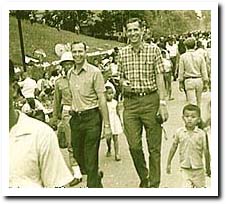
|
|
|
"History has the cruel reality of a nightmare, and the grandeur of man consists in his making beautiful and lasting works out of that real substance of that nightmare. Or, to put it another way, it consists in transforming the nightmare into vision; in freeing ourselves from the shapeless horror of reality--if only for a moment--by means of creation." - Octavio Paz
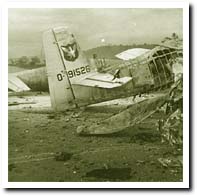
Nightmare at LP
|
Laotian mythology tells of the giant frog that ate the moon. This in reality is how the Lao explain a lunar eclipse. The disappearance of the moon is taken as a bad omen, and evil spirits are present. This superstition sets the stage for bad things to happen in the land. So the Lao make a great effort of scaring the frog away from the moon. They fire their guns into the air and make as much noise as they can. The frog is frightened by the noise and it releases its grip on the moon and it is restored to its original shape. Now peace and prosperity can return to the land. So it was in late 1966 and early 1967, when we were trying to loosen the grip of encroaching enemy forces.
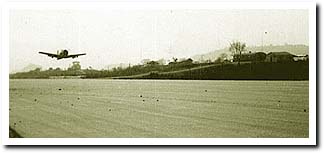
Looking across at LP Base Operations
|
During this period, North Vietnamese (NVA) and Pathet Lao forces began probing the defenses around Luang Prabang and the Airfield. There were several instances where patrol activity was detected in and around the city proper. I approached the Lao Army commanders about my concerns regarding the safety of the T-28s and H-34 Helicopters. Our security problem was increased when Air America H-34s remained overnight, as they were parked alongside the RLAF airplanes. I was assured that perimeter defenses had been strengthened and army personnel in the area had been reinforced and that there was adequate protection for the aircraft as well as to provide for the safety of our personnel.
Changes at LIMA-54
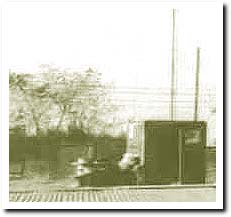
AN/GR 26 Communications Van
|
In late December 1966 there were some changes made to our operation, I had been asked if I would allow an Army COMMO van to be co-located with the AOC. AIRA said it was okay and we placed it behind the building. For security we surrounded it with lots of concertina wire, and because of the classified equipment, we had to have an Army guy in that van 24 hours a day. I believe its proper designation was an AN/GR 26 and it was airlifted in from Okinawa along with the four radio operators that it would take to operate it. They were placed under the operational control of the AOC commander
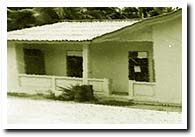
Small AIRA house
|
The van came fully equipped with itís own self-contained generator, secure Teletype capabilities and two HF radios. We had a single side band Collins set up at our main house in LP, but all coded messages had to be encoded and decoded by hand from the CAC tables. Having the van made things easier and made our CAS friends more comfortable about the increased security of our communications.
In addition, the radio operators were able to hook up antennae where they could communicate back to the states. Using the stateside call sign of the radio guy, they would use the MARS radio net to call home. The Army guys were real pros and were full of ideas on how we could use the equipment; some of the ideas were even legal. It worked great until the signal was picked up by COMINT flights in the area and the Embassy called me on the carpet and told me to please discontinue the long distance service for the troops.
Vientiane also sent me word about another transmitter operating in the LP area and wanted me to shut down the local missionary who had his own HF radio. He too was picked up by the COMINT flights. I finally convinced Vientiane that he was working with a higher authority than I was. The Embassy relented and he was allowed to continue his radio traffic. He probably wasnít a missionary at all, but the local spy reporting on our activities.
Just kidding about the missionary, we knew who our big spy was. He was the Chinese fellow who ran the icehouse at the river bridge. He was always taking our picture and pictures of the airfield especially when the T-28s were taking off.
NVA Commandos
Now that we had replaced most of our T-28s, we had been able to increase the daily sortie rate significantly. We knew from Intel reports that we were hurting the bad guys with the T-28s, but never thought that the NVA would be bold enough to make an attack on the airfield that was directed at the airplanes and our personnel. Unknown at the time, we had made a bad mistake. We allowed the Lao armament personnel to pre-load the aircraft for the next days missions to save time. This meant there were 9 fully loaded T-28s on the ramp. It made for, literally, an explosive situation.
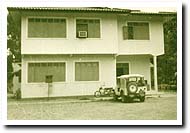
Big AIRA house
|
Shortly after midnight on February 2nd, the day of the attack, I was awakened by the sound of automatic weapons fire and explosions that sounded like mortars or grenades somewhere close by. I picked up the Swedish K and slowly opened the door and looked outside. We had a couple of guards posted at the gate and in the compound and they were no where to be seen. I slipped on a pair of shorts and made my way to the big house. I was met inside the door by some very excited troops who wanted to know what the hell was going on. The noise of battle seemed to come from the hooches behind our compound and was getting closer. Then there was a series of larger explosions that seem to come from the airfield. The sky reflected the fire from something burning.
I had the troops turn off all the lights, lock up and assume a defensive posture in case the compound came under attack. The firing over towards the river had eased up but the explosions from the vicinity of the airfield now came with greater frequency. A very concerned ARMA LCOL came by and suggested that we make our way out to the airfield. to check out the source of the explosions. I wasnít going anywhere until I could put on dark clothing and pick up my Swedish K. We took my jeep and proceeded to the bridge between town and the airfield. Lao Security Forces had closed the bridge and had set up defensive positions to repel an attack on the city. The ARMA guy in his excellent French convinced the troops that we were required on the other side of the bridge and there would be all hell to pay if we were detained any longer.
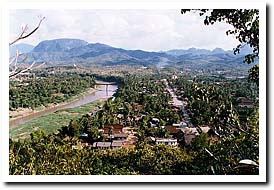
Downtown Luang Prabang
and Bridge to the Airport
(click on picture to enlarge)
|
We crossed the bridge and proceeded cautiously down the road without lights towards the airfield. It was easy to see the road because of the glare from the large fires that were burning. Combat sounds were increasing and we found ourselves in the midst of friendly troops who told us they were returning fire at enemy forces south of the airfield. I hadnít seen anything to shoot at and was skeptical of the information that we were given. Further down the road we ran into the FAR Commander, Col. Bounchan. He briefed us on what he knew. He said that the airfield was infiltrated by NVA commandos who had planted explosive satchel charges and systematically blew up the T-28s. The ensuing fires from the T-28s created a situation that resulted in tremendous secondary explosions from the bombs on the aircraft. Any FAC would have given a months pay to have been able to report secondary explosions of that magnitude. The explosions were continuous for about an hour.
I had other concerns as well because I had a man still at the AOC. It was the Army Commo guy that was guarding the COMMO van. Suddenly there was this tremendous explosion with a gigantic ball of fire that billowed up from the East End of the airfield. It was the bomb dump. I donít know if it was from charges placed by the NVA or was a sympathetic secondary explosion resulting from other explosions in the area. This last explosion did a number on the AOC. The windows were all blown out and most of the roof was gone. With the AOC in shambles, I now had real concerns about the safety of the Commo guy.
I wasnít sure that anyone could have survived that last explosion. At this point, not being able to do anything about the fires and not wanting to take any further risks, I decided it was time to retreat back down the road and check on my troops back at the house. I later found out that the Commo guy was long gone from the AOC when the ammo dump exploded. The remaining Army guys back in the compound took charge and were very helpful in calming down my troops. Just having them there gave us some credibility in case of a firefight.
We made our way back to the compound, the houses were still blacked out and the troops were hunkered down on the second floor, and I hoped that I wouldnít be shot as I came through the front door. It wasnít long before the whole contingent had assembled in the living room. I briefed the troops on what I knew and the necessity for everyone to sit tight until daylight. There was still considerable automatic weapons fire and explosions from what sounded like grenades in our vicinity. It seemed to be coming from the area behind us towards the river. I had recently created a safe area in my room by placing .50 cal. ammo cans full of sand around a mattress on the floor with the metal cot and another mattress resting on top of the ammo cans. I canít remember where I had first heard about doing this, but I think the CAS guys used sandbags and ammo cans at Nam Bac and I was sure it would work here. If we were attacked or mortared, it would allow me to roll off the bed for protection and or go to sleep on the floor. At the same time, I could watch the door without exposing myself. With all of the nightís activity, my adrenaline level was so high it made sleep impossible.
I hadnít been back in my room very long, when there was a flurry of activity outside with a lot of excited people running from out of the darkness and through our courtyard shooting at the house and into the empty rooms. Suddenly, my door was kicked opened and I heard an object hit the wall shortly followed by a loud bang. I was told later that it was a concussion grenade. The pressure from the explosion pushed me into the mattress on the floor and I couldnít hear or see anything for several seconds. I could smell the acrid smoke that filled the room, and after I regained my composure, I started firing my Browning 9mm through the open door instinctively. At about the same time through the open door I saw that our Guards had returned and were firing at the bad guys as they departed.
I looked around the room. My bed and ammo cans had absorbed most the force of the blast but my new curtains were burning. I yanked them down and threw them into the courtyard. Not wanting to expose myself to further attack, I returned to my position behind the ammo cans and waited for daylight. It was a long night. My guys on the second floor missed the action. When we were able to check for battle damage, we found out that we had come through it in good shape. We had one bad guy down in the courtyard and evidence that possibly others had been carried off.
There were no casualties among our troops but the little guys that lived in the hooches behind us had a rough time of it. Most of the firing we heard behind us was the NVA firing hundreds of AK rounds through the walls of their hooch. I was told that six of the little guys got hit. Our missing Commo guy showed up at daybreak with a great story about where he was during the attack. In 1969, the Embassy built us a bunker up next to the big house. Never used it, was too hard to find in the dark. Besides after one of our guards found a snake in it, I couldnít get any of the troops to go near it.
Ring Side Seat for the Big Show
Prior to the attack on the airfield, our Army friend had shut down the generator and was sitting in his chair leaning back against the side of the van gazing at the stars. All at once he noticed 30 or 40 guys come out of the darkness run past the concertina wire and around the side of the AOC. He sat there unable to move not knowing what it was that he was witnessing.
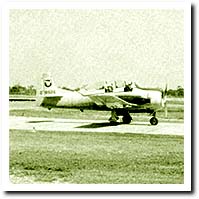
526 before
NVA Satchel Charge
|
He got up from his chair and went to the edge of the wire to see where all those guys had gone. He was looking towards the ramp when the first satchel charge went off. Our guy immediately threw himself on the ground to gather his thoughts and figure out what he needed to do. First, he got up and ran back to the van, retrieved his weapon and assumed a prone position back outside the van. Not being sure the guys he saw run past the wire were bad guys, he couldnít decide whether or not to fire at the troops on the flight line.
By this time explosions were going off all over the field. It suddenly occurred to him that this was the real thing and the airfield was under attack and there were things he had to do. It had been drilled into him that the security of the van and its contents were very important and must be safeguarded at all times. The Army had instructions and procedures to follow for just this situation. It called for the distruction of the classified material in the filing cabinet and the classified Teletype.
Remembering what he needed to do, he went back inside the van and located the thermite grenades that had been furnished for just this type of situation. The instructions said to pull the pin of the first grenade and placed it in the top drawer of the filing cabinet. When the thermite starts to burn, it will burn right through metal drawers all the way to the ground. It called for the second grenade to be placed on top of the Teletype. Thermite would destroy the machine ensuring that nothing usable is left. What the instructions didnít say was that it creates a tremendous mess that would need to be cleaned up later. After the thermite was detonated, our Commo guy picked up his weapon and returned to the position he had hastily constructed outside the van. He now had a ringside seat to a world class fire works display.
His major concern at this time was how to get out of this predicament as he was trapped inside the wire. He began the process of pulling up the ground stakes holding down the concertina so that he could pull it away from the side of the AOC. This was necessary to create a space large enough that he could slip through. He froze when he heard the noise of running troops. He looked up and saw the same 30 or 40 troops that came by earlier exiting the area by a route that retraced the way they used to get in.
As the last guy in the NVA procession was opposite the concertina, he slipped through the hole in the wire and figured that he wouldnít be noticed if he fell in behind the last man. The group went off into the night with the reflection of the fires on their backs. When the retreating NVA turned left at an intersection, our guy turned to the right and proceeded to the river. Because he heard the big secondary explosion and all of the firing that was happening over our way, he decided he should hole up until morning when he could see where he was going.
At daylight, he made his way to the bridge and came home, and we were sure happy to see him. It was luck that he had shut down the noisy generator about midnight. He eliminated a situation that would certainly have focused attention to the van, and he was surprised that the bad guys never looked behind them, but maybe they did and thought he was one of them. I told him he was also lucky that some of the long-range shooters we had been with earlier hadnít shot him.
End of the Nightmare
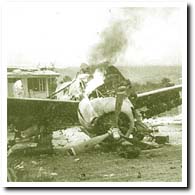
One of six T-28's
totally destroyed
...three others were heavily damaged
|
We were in shock after daylight came and we were able to get to the airport and survey the damage. There were still fires burning all over the ramp area. The little guys, not having fire or crash equipment did a superb job controlling the fires the best they could by dumping sand on them. All nine of the T-28s that were at LP at the time were heavily damaged plus two H-34s. Everywhere you looked there were aircraft parts and unexploded bombs. It was devastating, like a scene from Danteís Inferno.
All of our flight line equipment was destroyed or heavily damaged, and the AOC would need to be completely rebuilt. We were definitely out of business as an effective strike force. I initially thought that it would take days for us to clean up the debris, repair the runway and the ramp. Also at the time, I didnít know where we were going to get replacement aircraft. I assumed that we would have to beg borrow and steal T-28s anywhere we could find them. Out of the nine T-28s at LP, six were totally destroyed and three were heavily damaged. The damaged airplanes were shipped down to the Air America facility at Udorn for repair and would soon return to action.
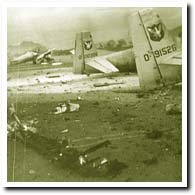
Pathet Lao take revenge at LP
|
Damage to the compound where we lived was minimal. The small house where I had been staying was in the worst shape, but I could move into the big house where there was plenty of room until repairs could be made. We salvaged what we could from the AOC but the building was too badly damaged for us to use. We didnít know at the time that Waterpump had retrieved the T-28s that were confiscated during the coup, and we were able to get six of those aircraft back within two days.
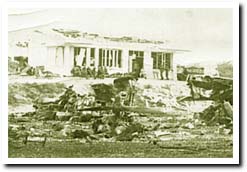
Air Operations Center
damaged by enemy attack
|
|
|
The Requirements Office (RO) sent us munitions and replacement parts to replace almost everything lost in the attack. The Embassy negotiated an in-to-plane contract with Esso to refuel all of our aircraft. Everyone rolled up their sleeves and got to work.
We were able to return to combat ready status three days after the attack on the airfield. The biggest continuing problem we had was filling in the bomb craters and patching the runway. Everyone agreed that it was important for the little guys to start flying as soon as possible. We wanted to give the bad guys the impression that the raid was only a nuisance and only slowed us down.
Postscript
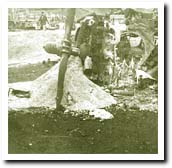
Sand used to
put out burning T-28
no fire department
available
|
In a few days, the ringing in my ears had subsided and my hearing was almost back to normal. I felt as though a ton of bricks had fallen on me and I would be sore for awhile. Everyone was ready to start flying again. Our T-28s were probably dropping bombs on the NVA as they returned to their base camps. I would have liked to listen in on their conversations, as I am sure they were wondering where all of these airplanes were coming from. I am probably the only AOC commander to lose all of his airplanes twice within a 90-day period. It was a situation that I never want to experience again. The NVA did hit LP again in 1968, but I wasnít there that time. The side of the runway opposite the ramp became known as the T-28 graveyard. They brought in a bulldozer dug a trench and pushed all the wreckage in and covered it up. I understand that they added some more wreckage to the hole in 1968. One thing for sure, the Lao were never allowed to pre-load bombs on the airplanes again.
1967 - The End of the Trail
Murphyís Law says, ďWhatever can go wrong, will, and when you least expect it.Ē (And, of course, we all know that Murphy was an Aviator.) In my case, Murphy was correct beyond his wildest expectations. Fortunately for me, however, he failed to follow through. Not even Murphy could have conceived what was about happen to me.
It is surprising how you can go through so many harrowing experiences over the past year and never get a scratch; and when you least expect it, something quite ordinary just jumps up and smacks you down. Several weeks after the attack on LP, I had to ride a med-evac out of Thailand to the hospital in Tachikawa, Japan where I would spend 2 months recovering from injuries and ailments incurred helping out the little guys and my CAS friends.
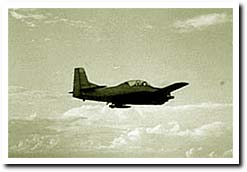
T-28 flying air cover
|
It all started with a SAR request from Lima Site 118A through our local CAS guys. They were asking the RLAF to provide T-28 cover support for the infil of one of their Intel teams into northern Laos, somewhere near the China border.
I donít know why but CAS called their team infil missions SARs. Typically a SAR had two Air America H-34s (one empty for backup), and if the threat called for it, a flight of two to four T-28s to escort the choppers and fly cover for the infil. Because of the location and duration of the flight, I was asked to ensure that the mission got off as planned and the Lao pilots knew what to do. As we were still short of pilots, I felt it was time for me to fly another test hop. Most SAR missions are uneventful and for this mission I was assured it would be a milk run.
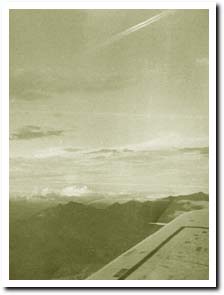
Across the mountains is China
|
We joined up with the H-34s just north of Nam Yu and proceeded to the point up north where the team would be dropped off. The flight up to this point was uneventful. The area that was picked for the drop off seemed all right, but something about it didnít look right to the H-34 pilot and at the last minute, he took a wave off. This was a smart move on his part, as the bad guys seemed to know we were coming and were ready for us.
There had been no way for us to check the security of the LZ ahead of time, and the bad guys had pre-positioned several 12.7mm heavy machine guns around the area that were set up to present a withering cross-fire. In less than five minutes they shot down two T-28s and killed Lt Pheuak the flight leader, who was one of my new replacement pilots. Lt. Pheuak was shot down on his first pass to clear out the area around the LZ where the ground fire was coming from. My aircraft was hit trying to cover the retreating H-34s. The 12.7s were hammering me pretty good and I took a round in the propeller housing that caused the engine to over speed. There was no alternative but to shut down the engine to keep it from disintegrating. As luck would have it, I was alive and had the aircraft safely on the ground, but in a rice paddy somewhere in northern Laos. The real stroke of luck came in having the empty H-34 in position to make a quick pick-up. Thank you Air America.
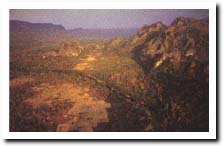
Northern Laos
near the Chinese border
(click for enlargement)
|
The mission was a disaster, but I didnít have to walk home. I can also tell you that the stuff they put in their rice paddies is not nitrogen fertilizer. Lt Pheuakís aircraft went straight in and the wreckage was burning. You could tell by looking that there was no survivor. Lt Pheuakís body was later recovered. The Air America H-34s and the CAS team were okay and would live to fight another day. I guess that I was fortunate to only have a bum shoulder and severely strained ligaments in my ankles. Later, I also came down with Hepatitis, which was bad stuff and complicated and lengthened my stay in the hospital. The Doctor said it probably was from the feces in the rice paddy.
After the incident, the only problem I had was how to explain the loss of my airplane and my injuries. Again I was lucky, no one ever asked so I didnít have to say anything. It also didnít hurt to be out of the country for two months. It was just reported as an incident as there were more important things going on. It seems I have a real propensity for crash landing T-28s, as this was my second one in less than a year. My cat was going through his nine lives at far too fast a pace.
Postscript
I was beginning to think there was no way for me to get out of Tachikawa and back to LP. This all happened in the middle of winter and it gets cold in Japan. I had no winter clothes with me - - No ID card, no orders, no uniform, no nothing. I had to hand pick all the white embroidery off of a maroon corduroy hospital jacket to have something warm to wear outside the hospital. After the Doctors said that I was to be released from the Hospital, I had to figure out a way to get back to LP. To get home, I had to pull the old ďI can't tell you, but I can tell your commander who I amĒ trick.
I got all the way back to Bangkok on bluff and my good looks. From Bangkok it was easy to get to Vientiane. I just checked in with Air America dispatch and after checking me out with AIRA, they put me on a flight to Udorn and from there I hopped a flight to Vientiane. I spent a couple of days getting caught up on all that had happened up country since I had been gone and then it was off to LP.
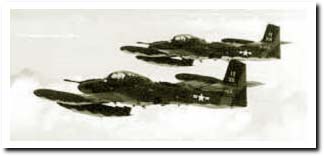
Send me in Coach - I'm ready to go
|
After my release from the hospital in early May 1967, Col Pettigrew generously allowed me to return to LP but in a different capacity. Because I would be grounded for awhile, I was given the job of teaching the Laotian Army at LP the Principles of Air Ground Operations and how to set up a Tactical Air Control System. I really believe they were starting to get the general idea when it came time for me to rotate back to the states. Now, I was looking forward to going home, as I had an assignment to be a flight instructor in the first A-37 training squadron at England AFB. Col. Bill Thomas (the Roadrunner) would be my squadron commander.
When I returned to LP in 1969, I was pleasantly surprised to see they had established a Joint Operations Center (JOC) that met each morning and assigned priorities to potential targets and issued a daily FRAG Order. They were doing it just like I taught them.
In my series of short stories, I have only related some of the more interesting activities about my experiences in Laos. There are many more equally as exciting and important. I am sorry that it has taken so long to finally write these vignettes. My principal motivation for writing these stories at this time is I didnít want to get so old that I couldnít remember them anymore. I felt that I owed it to my friends and family to put a story behind the many pictures that I have collected over my years in Special Operations. I apologize for leaving anyone out of my stories any omissions were unintentional.
|